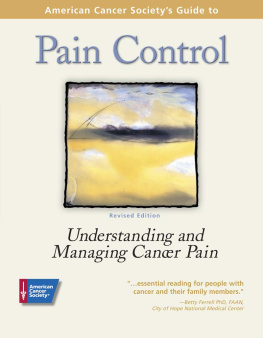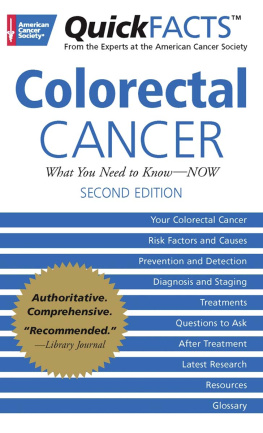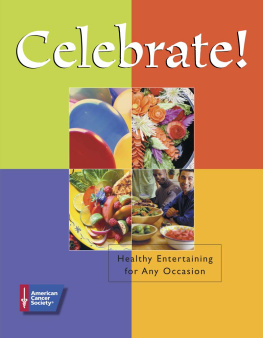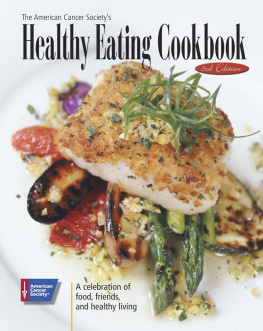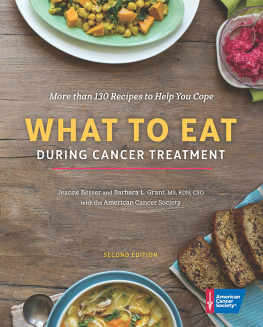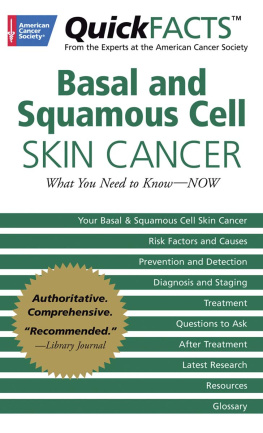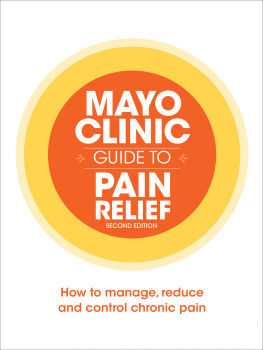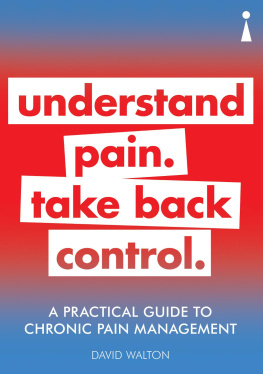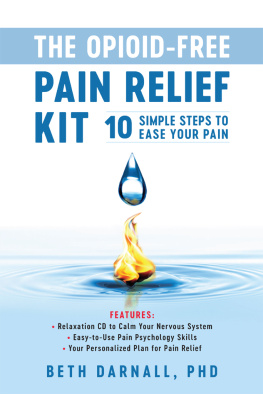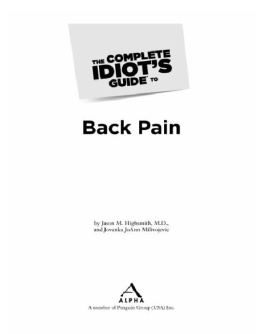
Books published by the American Cancer Society
A Breast Cancer Journey: Your Personal Guidebook, Second Edition
American Cancer Society Consumers Guide to Cancer Drugs, Second Edition, Wilkes, Ades, and Krakoff
American Cancer Societys Complementary and Alternative Cancer Methods Handbook
American Cancer Societys Guide to Complementary and Alternative Cancer Methods
Angels & Monsters: A childs eye view of cancer, Murray and Howard
Because Someone I Love Has Cancer: Kids Activity Book
Cancer in the Family: Helping Children Cope with a Parents Illness, Heiney et al.
Cancer: What Causes It, What Doesnt
Caregiving: A Step-By-Step Resource for Caring for the Person with Cancer at Home, Revised Edition, Houts and Bucher
Coming to Terms with Cancer: A Glossary of Cancer-Related Terms, Laughlin
Couples Confronting Cancer: Keeping Your Relationship Strong, Fincannon and Bruss
Crossing Divides: A Couples Story of Cancer, Hope, and Hiking Montanas Continental Divide, Bischke
Eating Well, Staying Well During and After Cancer, Bloch et al.
Good for You! Reducing Your Risk of Developing Cancer
Healthy Me: A Read-along Coloring & Activity Book, Hawthorne (illustrated by Blyth)
Informed Decisions: The Complete Book of Cancer Diagnosis, Treatment, and Recovery, Second Edition, Eyre, Lange, and Morris
Kicking Butts: Your Path to Quitting Smoking
Our Mom Has Cancer, Ackermann and Ackermann
Also by the American Cancer Society
American Cancer Societys Healthy Eating Cookbook: A celebration of food, friends, and healthy living, Second Edition
Celebrate! Healthy Entertaining for Any Occasion
Kids First Cookbook: Delicious-Nutritious Treats to Make Yourself!

Published by
American Cancer Society
Health Promotions
1599 Clifton Road NE
Atlanta, Georgia 30329, USA
2004 American Cancer Society
All rights reserved. Without limiting the rights under copyright reserved above, no part of this publication may be reproduced, stored in or introduced into a retrieval system, or transmitted, in any form or by any means (electronic, mechanical, photocopying, recording, or otherwise), without the prior written permission of the publisher.
Printed in the United States of America
Cover designed by Jill Dible
5 4 3 2 1 04 05 06 07 08
Library of Congress Cataloging-in-Publication Data
American Cancer Societys guide to pain control : understanding and managing cancer pain. Rev. ed.
p. cm.
Previous ed. has subtitle: Powerful methods to overcome cancer pain.
Includes bibliographical references and index.
ISBN 0-944235-52-2 (pbk. : alk. paper)
1. Cancer pain. 2. cancer painTreatment. I. Title: Guide to pain control. II. American Cancer Society.
RC262.A645 2004
616.0472dc22
2003025526
Brief Contents
CHAPTER 1
Understanding Cancer Pain
CHAPTER 2
Coping with the Emotional andSocial Impact of Cancer Pain
CHAPTER 3
Achieving Effective Pain Control
CHAPTER 4
Describing and Measuring Your Pain
CHAPTER 5
Pain Relief through Medication
CHAPTER 6
Other Medical Approaches to Pain Management
CHAPTER 7
Complementary Nondrug Treatments
CHAPTER 8
Managing Side Effects of Opioids
CHAPTER 9
Cancer Pain in Specific Groups
EDITOR
Amy Brittain
MANAGING EDITOR
Gianna Marsella, MA
BOOK PUBLISHING MANAGER
Candace Magee
DIRECTOR,PUBLISHING
Diane Scott-Lichter,MA
DIRECT CHANNELS
ANAGING DIRECTOR
Chuck Westbrook
EDITORIAL REVIEW
Terri Ades, MS, APRN-BC, AOCN
Director of Cancer Information
American Cancer Society
Atlanta, Georgia
Betty R. Ferrell, PhD, FAAN
Research Scientist
City of Hope National Medical Center
Duarte, California
A Note to the Reader
The information contained in this book is not intended as medical advice and should not be relied upon as a substitute for talking with your doctor. This information may not address all possible actions, precautions, side effects, or interactions. All matters regarding your health require the supervision of a medical doctor who is familiar with your medical needs. For more information, contact your American Cancer Society at 800-ACS-2345 or http://www.cancer.org.
Contents
APPENDIX A
Cancer Pain Drug Information
APPENDIX B
Guidelines for Pain Management
Foreword
by Betty R. Ferrell, PhD, FAAN, Research Scientist City of Hope National Medical Center, Duarte, California
P AIN HAS THE POTENTIAL TO NEGATIVELY AFFECT physical, psychological, social, sexual, and spiritual well-being, as well as upset family members and caregivers. Providing all available pain-relief methods to people with cancer is not only essential for preserving quality of life, it is critical to successful cancer treatment. Patients are better able to tolerate cancer treatment when their pain is alleviated.
The American Cancer Society is dedicated to diminishing suffering from cancer and has focused major effortsincluding the publication of the first and revised editions of this booktoward addressing the critical issue of pain management and enhancing quality of life for people facing cancer.
Advances in Understanding Pain
Major advances in cancer prevention, early detection, diagnosis, and treatment have been mirrored by major advances in the understanding and treatment of cancer pain. In 1994, the federal government issued guidelines for the treatment of cancer pain. These initial guidelines, published by the Agency for Health Care Policy and Research, have been reinforced and elaborated upon through major documents from the National Cancer Institute, professional organizations, and consumer groups. All of these groups have consistently agreed that pain negatively affects quality of lifeand that, unfortunately, pain is often undertreated.
Partnering to Manage Pain
The successful management of pain requires a partnership between patients and health care professionals. People with cancer and caregivers who are informed about cancer pain will better understand the importance of expressing pain, overcoming fears of addiction and tolerance, exploring appropriate nondrug methods of pain relief, and expecting that all means available are used to provide optimal pain relief. Cancer care professionals can help improve quality of life for people in pain by understanding how to overcome social and cultural barriers, balance side effects of pain-control methods, and assess and treat pain.
The Role of this Book in Pain Control
The American Cancer Societys Guide to Pain Control was first published in 2001 to inform patients and their families about cancer pain, how to manage it, and how to obtain the best pain-control care possible. The revised edition of this comprehensive resource for patients, families, and health care professionals reflects updated developments in pain control, with an increased focus on practical information for people with cancer. It is essential reading for people with cancer and their family members. This book explains how to take control of cancer pain and how to obtain emotional and social support, and emphasizes that pain can usually be alleviated.
Next page
